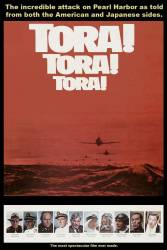Factual error: When the Japanese planes attack the airfield, none of the American planes have numbers or letters, just a star.
Factual error: In a scene where the USS Arizona blows up, a Kingfisher aircraft is seen toppling from the catapult on Arizona's number 3 turret. On the morning of the attack, Arizona's two aircraft were on Ford Island undergoing maintenance.
Factual error: Throughout the movie all American army enlisted men wear officer belt buckles instead of the open-face EM belt buckles they should be wearing.
Factual error: None of the jeeps shown in this film are correct for 7 Dec. 1941. The standard jeep grill didn't appear until Feb. of 1942. All jeeps up to that point were either Bantam, Ford, or Willys prototypes or the first standardized jeeps (called slatgrills) that used welded bars for a grill, as did most military trucks of the time.
Factual error: In the opening scene of Washington DC the building on the left is the Museum of American History which wasn't built until around 1959.
Factual error: When the Japanese planes have arrived in Hawaii and are flying across the island before they arrived to bomb Pear Harbor, there is a microwave tower in the background. Microwave communications was not invented until much later in the century, so there were no microwave antennas or towers.
Factual error: When the Japanese submarine is trying to sneak into Pearl Harbor, the ship identified as the USS Ward is a much newer type of destroyer, not the World War I vintage with 4 smoke stacks that the Ward actually was.
Factual error: When the Japanese planes first arrive, they fly through the mountainous area near Schofield Barracks. The white cross that is seen at this point wasn't erected until 1962.
Factual error: In one scene you see a damaged B-17 about to land when he gets a call from the tower saying that he had a Zero on his tail and telling him to go around. This would never happen. A heavy B-17 (much less a damaged one) would never be able to outrun a Zero, especially after trying to land. The pilot's best option would have been to get it on the ground as soon as possible and to run like hell.
Factual error: The camera cuts to an actor's wristwatch just before the attack. The watch is a Caravelle, which was not sold by Bulova until about 1960.
Factual error: Take a look at the harbor tug, fighting the fires on the battleships, it sports a TV antenna.
Factual error: When the female civilian pilot is teaching a student, they are shown flying in a Boeing Stearman biplane. The actual plane in that event was an Interstate Cadet S-1A, a high wing monoplane. The instructor was Cornelia Fort who later became the second WASP. She was killed 21 March 1943 while ferrying an aircraft, becoming the first female pilot killed in WW2.
Factual error: In any scene when they are pulling the B-17's around, those aren't the right ones. The earlier B-17's had no tail gunner. They weren't added until shortly after the US entered the war. Before then, the pilot would fishtail so that the port and starboard gunners would have a short time to shoot at pople coming from behind them.
Factual error: None of the B-17 bombers had problems with their landing gear during the attack.
Factual error: In the deck scenes of the U.S.S. Nevada, she has three fourteen inch guns mounted in each of her four turrents. The Nevada did have triple mount guns, but only in the first and third. The second and third turrets only had two.
Factual error: The scene where the Japanese planes are taking off from their carriers shows a mix of aircraft in motion, mainly reproductions of the Zero, Kate, and Val aircraft that were used. In the actual event, the Zeros always left first as they needed the least space, and the heavier planes last. This is not the case in the film.
Factual error: The radar installation at Opana Point on Oahu was a newly developed Westinghouse type scr-270. This is not the one shown in the movie, which is of more recent vintage.
Factual error: Some of the 3 man Japanese torpedo bombers taking off only have the pilot on board.
Factual error: At least twice in the movie you can see across the harbor a ship with the number 1048 on its bow. That ship is the USS Sample, which wasn't commissioned until 1968.





